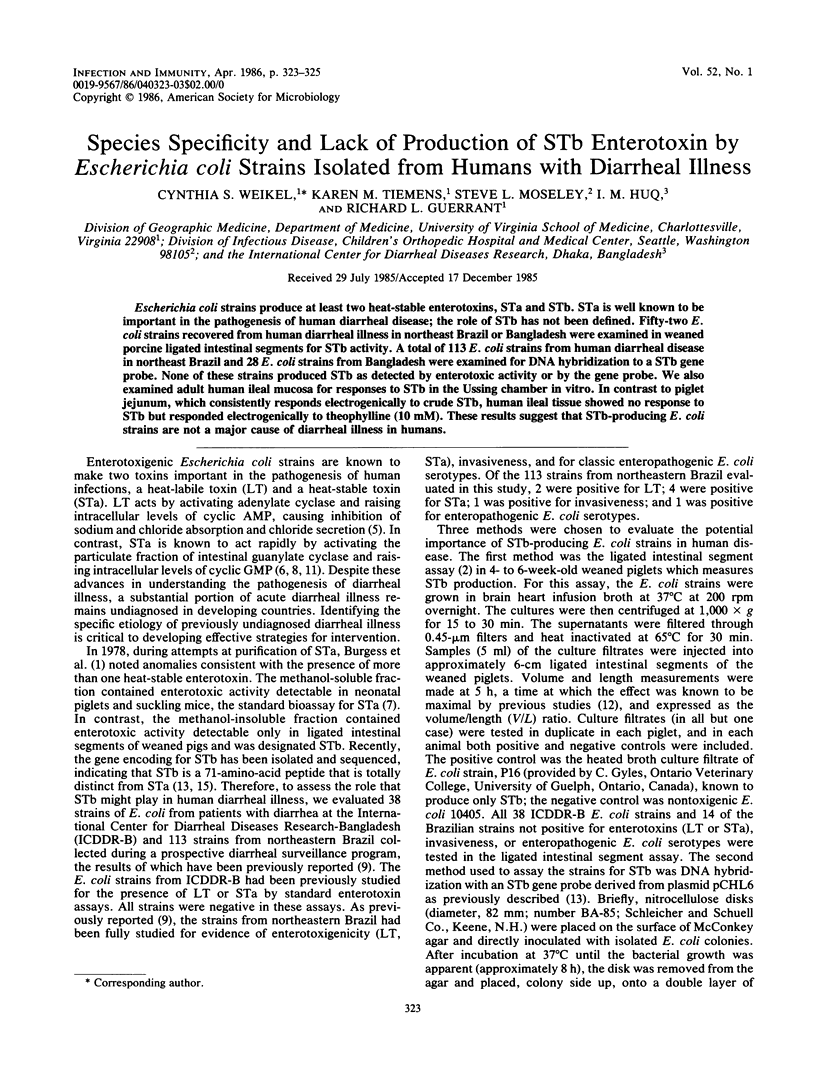Abstract
Escherichia coli strains produce at least two heat-stable enterotoxins, STa and STb. STa is well known to be important in the pathogenesis of human diarrheal disease; the role of STb has not been defined. Fifty-two E. coli strains recovered from human diarrheal illness in northeast Brazil or Bangladesh were examined in weaned porcine ligated intestinal segments for STb activity. A total of 113 E. coli strains from human diarrheal disease in northeast Brazil and 28 E. coli strains from Bangladesh were examined for DNA hybridization to a STb gene probe. None of these strains produced STb as detected by enterotoxic activity or by the gene probe. We also examined adult human ileal mucosa for responses to STb in the Ussing chamber in vitro. In contrast to piglet jejunum, which consistently responds electrogenically to crude STb, human ileal tissue showed no response to STb but responded electrogenically to theophylline (10 mM). These results suggest that STb-producing E. coli strains are not a major cause of diarrheal illness in humans.
Full text
PDF


Selected References
These references are in PubMed. This may not be the complete list of references from this article.
- Burgess M. N., Bywater R. J., Cowley C. M., Mullan N. A., Newsome P. M. Biological evaluation of a methanol-soluble, heat-stable Escherichia coli enterotoxin in infant mice, pigs, rabbits, and calves. Infect Immun. 1978 Aug;21(2):526–531. doi: 10.1128/iai.21.2.526-531.1978. [DOI] [PMC free article] [PubMed] [Google Scholar]
- Echeverria P., Seriwatana J., Patamaroj U., Moseley S. L., McFarland A., Chityothin O., Chaicumpa W. Prevalence of heat-stable II enterotoxigenic Escherichia coli in pigs, water, and people at farms in Thailand as determined by DNA hybridization. J Clin Microbiol. 1984 Apr;19(4):489–491. doi: 10.1128/jcm.19.4.489-491.1984. [DOI] [PMC free article] [PubMed] [Google Scholar]
- Echeverria P., Seriwatana J., Taylor D. N., Tirapat C., Chaicumpa W., Rowe B. Identification by DNA hybridization of enterotoxigenic Escherichia coli in a longitudinal study of villages in Thailand. J Infect Dis. 1985 Jan;151(1):124–130. doi: 10.1093/infdis/151.1.124. [DOI] [PubMed] [Google Scholar]
- Field M., Graf L. H., Jr, Laird W. J., Smith P. L. Heat-stable enterotoxin of Escherichia coli: in vitro effects on guanylate cyclase activity, cyclic GMP concentration, and ion transport in small intestine. Proc Natl Acad Sci U S A. 1978 Jun;75(6):2800–2804. doi: 10.1073/pnas.75.6.2800. [DOI] [PMC free article] [PubMed] [Google Scholar]
- Giannella R. A. Suckling mouse model for detection of heat-stable Escherichia coli enterotoxin: characteristics of the model. Infect Immun. 1976 Jul;14(1):95–99. doi: 10.1128/iai.14.1.95-99.1976. [DOI] [PMC free article] [PubMed] [Google Scholar]
- Guerrant R. L., Hughes J. M., Chang B., Robertson D. C., Murad F. Activation of intestinal guanylate cyclase by heat-stable enterotoxin of Escherichia coli: studies of tissue specificity, potential receptors, and intermediates. J Infect Dis. 1980 Aug;142(2):220–228. doi: 10.1093/infdis/142.2.220. [DOI] [PubMed] [Google Scholar]
- Guerrant R. L., Kirchhoff L. V., Shields D. S., Nations M. K., Leslie J., de Sousa M. A., Araujo J. G., Correia L. L., Sauer K. T., McClelland K. E. Prospective study of diarrheal illnesses in northeastern Brazil: patterns of disease, nutritional impact, etiologies, and risk factors. J Infect Dis. 1983 Dec;148(6):986–997. doi: 10.1093/infdis/148.6.986. [DOI] [PubMed] [Google Scholar]
- Gyles C. L. Limitations of the infant mouse test for Escherichia coli heat stable enterotoxin. Can J Comp Med. 1979 Oct;43(4):371–379. [PMC free article] [PubMed] [Google Scholar]
- Hughes J. M., Murad F., Chang B., Guerrant R. L. Role of cyclic GMP in the action of heat-stable enterotoxin of Escherichia coli. Nature. 1978 Feb 23;271(5647):755–756. doi: 10.1038/271755a0. [DOI] [PubMed] [Google Scholar]
- Kennedy D. J., Greenberg R. N., Dunn J. A., Abernathy R., Ryerse J. S., Guerrant R. L. Effects of Escherichia coli heat-stable enterotoxin STb on intestines of mice, rats, rabbits, and piglets. Infect Immun. 1984 Dec;46(3):639–643. doi: 10.1128/iai.46.3.639-643.1984. [DOI] [PMC free article] [PubMed] [Google Scholar]
- Lee C. H., Moseley S. L., Moon H. W., Whipp S. C., Gyles C. L., So M. Characterization of the gene encoding heat-stable toxin II and preliminary molecular epidemiological studies of enterotoxigenic Escherichia coli heat-stable toxin II producers. Infect Immun. 1983 Oct;42(1):264–268. doi: 10.1128/iai.42.1.264-268.1983. [DOI] [PMC free article] [PubMed] [Google Scholar]
- Moseley S. L., Huq I., Alim A. R., So M., Samadpour-Motalebi M., Falkow S. Detection of enterotoxigenic Escherichia coli by DNA colony hybridization. J Infect Dis. 1980 Dec;142(6):892–898. doi: 10.1093/infdis/142.6.892. [DOI] [PubMed] [Google Scholar]
- Picken R. N., Mazaitis A. J., Maas W. K., Rey M., Heyneker H. Nucleotide sequence of the gene for heat-stable enterotoxin II of Escherichia coli. Infect Immun. 1983 Oct;42(1):269–275. doi: 10.1128/iai.42.1.269-275.1983. [DOI] [PMC free article] [PubMed] [Google Scholar]
- SCHULTZ S. G., ZALUSKY R. ION TRANSPORT IN ISOLATED RABBIT ILEUM. I. SHORT-CIRCUIT CURRENT AND NA FLUXES. J Gen Physiol. 1964 Jan;47:567–584. doi: 10.1085/jgp.47.3.567. [DOI] [PMC free article] [PubMed] [Google Scholar]
- Weikel C. S., Guerrant R. L. STb enterotoxin of Escherichia coli: cyclic nucleotide-independent secretion. Ciba Found Symp. 1985;112:94–115. doi: 10.1002/9780470720936.ch6. [DOI] [PubMed] [Google Scholar]


